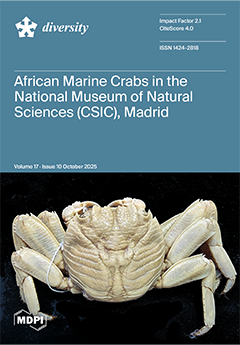Kobresia humilis, an alpine meadow-constructive species, has significant ecological and economic importance on the Qinghai–Tibetan Plateau (QTP). Understanding the diversity and structure of the rhizosphere microbiota associated with
K. humilis is essential for advancing microbiome engineering aimed at promoting sustainable ecosystem functioning
[...] Read more.
Kobresia humilis, an alpine meadow-constructive species, has significant ecological and economic importance on the Qinghai–Tibetan Plateau (QTP). Understanding the diversity and structure of the rhizosphere microbiota associated with
K. humilis is essential for advancing microbiome engineering aimed at promoting sustainable ecosystem functioning in alpine meadows. However, little is known about the composition of bacterial community associated with
K.
humilis and the environmental drivers affecting microbiota assembly on a larger scale. This study revealed that bacterial communities inhabiting the rhizosphere exhibited greater diversity and higher compositional dissimilarity than those within the root compartment (ANOSIM, R = 0.86,
p = 0.001). The bacterial genus
Sphingomonas was identified as the predominant taxon in both microbial niches. A total of 196 and 176 core genera were detected in the roots and rhizosphere, respectively, with chemoheterotrophy and aerobic chemoheterotrophy representing the dominant functional groups. Co-occurrence network analysis identified hub genera, including
Sphingomonas,
Rhodomicrobium,
Rhizobacter, and
Phyllobacterium within root, and
Allorhizobium-
Neorhizobium-
Pararhizobium-
Rhizobium,
Acidibacter,
RB41, and
Sphingomonas in the rhizosphere. Among the sampling sites, Haiyan (HY) emerged as the central hub (EIC
HY = 1), followed by Tianjun (EIC
root = 0.98; EIC
soil = 0.99) and Xinghai (EIC
root = 0.97; EIC
soil = 0.95). Redundancy analysis indicated that bacterial abundance in roots was significantly influenced by geographic variables, temperature, and edaphic factors, whereas bacterial communities in the rhizosphere were primarily affected by latitude, altitude, pH, and climatic conditions (
p < 0.05). Furthermore, the core bacterial genera exhibited stronger correlations with geographic and edaphic parameters than with climatic factors (
p < 0.05). Collectively, these results enhance the current understanding of
K. humilis–microbe–environment interactions within the alpine meadow ecosystems of the QTP.
Full article





